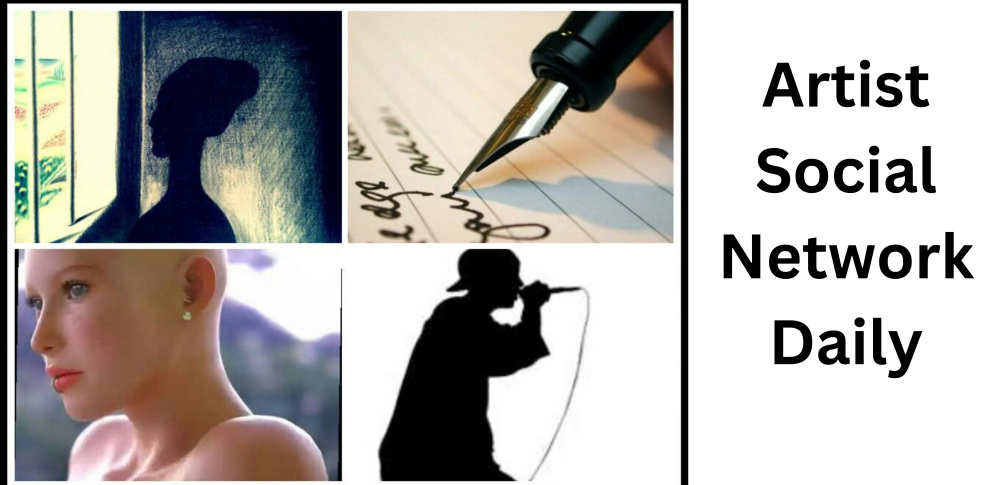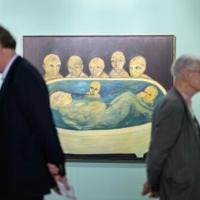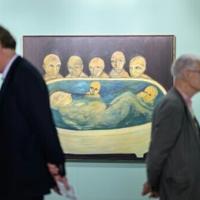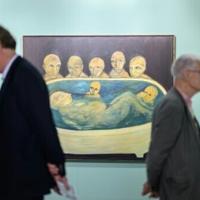Art Market
Shreya Ajmani
Apr 17, 2025 4:20PM
Interior view of Art Dubai Digital 2025. Photo by Cedric Ribeiro. Courtesy of Art Dubai and Getty Images.
“The fair of discoveries” is how artistic director Pablo del Val described Art Dubai 2025 during his opening remarks for the fair’s VIP day on Wednesday, March 16th. The Middle East’s leading art fair is returning for five days to the Madinat Jumeirah with a growing roster of more than 120 galleries representing 65 cities.
On the VIP day, the sprawling venue’s halls pulsed with anticipation as throngs of collectors bustled through the fair from morning until sundown. As the U.A.E. continues to grow as an art hub, the fair is well-positioned to further bolster its standing in a country that is drawing new galleries and collectors.
“The pace of change and innovation here is astonishing, and the market has evolved immeasurably since our launch in 2007,” said Art Dubai’s executive director, Benedetta Ghione. “We’re seeing a growing influx of artists and collectors relocating to Dubai from all over the world, which is already having a positive impact on the market.”
Highlights from Art Dubai 2025
Interior view of Art Dubai 2025. Photo by Cedric Ribeiro. Courtesy of Art Dubai and Getty Images.
Advertisement
While the number of galleries remains roughly the same as last year’s edition, Art Dubai 2025 includes 30 first-time galleries. The fair is split into four sections, the largest being Art Dubai Contemporary. Other sections include Bawwaba (meaning “gateway” in Arabic); Art Dubai Modern; and Art Dubai Digital.
“What’s most exciting this year is that, of all the editions we’ve hosted in Dubai, this one is the strongest in terms of quality,” said del Val. “We’re striking a fantastic balance between emerging and established artists, creating a dynamic, intergenerational dialogue.”
Fostering this intergenerational dialogue seamlessly was local stalwart Lawrie Shabibi, who had adjoining booths in the fair’s Modern and Contemporary sections. The Modern section showcased a solo display by Iraqi artist Mehdi Moutashar, with prices ranging from $12,000 to $85,000. The Contemporary section, meanwhile, featured a group show with works by Shaikha Al Mazrou, Mohamed Ahmed Ibrahim, Elias Sime, and Saif Azzuz, priced between $5,000 and $500,000. Fellow local heavyweight Leila Heller Gallery presented across both sections as well, with a never-before-exhibited 1966 work by Iranian artist Bahman Mohassess titled Starry Night in the Modern section, and a group Contemporary booth, “Resonance of Body, Soul, Faith, and Loyalty in the Romance of Leila and Majnun.”
The Modern section also featured strong presentations from the Indian gallery DAG, which showcased works by famed modernist M.F. Husain, and a compelling debut by London’s Richard Saltoun Gallery. Their booth included works by three artists featured in last year’s Venice Biennale main show: British Italian minimalist Romany Eveleigh, renowned Mozambican Portuguese modernist Bertina Lopes, and Austrian Italian Greta Schödl, a pioneering figure in text-based art. Also featured are works by Iranian American Samira Abbassy; the calligraphic works of Palestinian Maliheh Afnan; and Malaysian Australian Simryn Gill.
“Dubai, and the U.A.E. in general, is one of the most interesting and growing markets that we work with,” said Richard Saltoun director Niamh Coghlan. “The institutional collections, foundations, and private collections are curious, active, and engaging to work with. Having worked with several major museums and foundations over the past few years in the region, we knew we had to take a more active role and be more present.”
That shared sentiment was echoed across the fair. Just days before the fair opened, Perrotin inaugurated its new space in the heart of the Dubai International Finance Centre, near Sotheby’s and Christie’s. At the fair, the gallery presented standout works by Monira Al Qadri, alongside pieces by Takashi Murakami, Lee Bae, Shim Moon-Seup, and others, priced between €4,300 ($4,891) and $400,000.
Notable presentations across the Contemporary section included a shared booth by local gallery NIKA Project Space and Paris’s Iragui Gallery—two galleries that share a building in Paris. The diagonally split booth includes works by Mirna Bamieh, Tatar artist Nazilya Nagimova, and Adrian Pepe. Fellow local gallery Tabari Artspace debuted works by Saj Issa, while London’s Grosvenor Gallery presented a dual display examining masculinity in contemporary Pakistan through works by Faiza Butt and Anwar Saeed—who was once Butt’s professor.
Installation view of IRIS PROJECTS’s booth at Art Dubai 2025. Photo by Cedric Ribeiro. Courtesy of Art Dubai and Getty Images.
In the Bawwaba section, dedicated to booths featuring artworks made in the past year or specifically for the fair, Abu Dhabi’s IRIS Projects made a strong debut with a captivating presentation of works by Abdulla Al Othman. The artist’s site-specific installation continues his “Language & The City” series, previously shown at the Lyon Biennale, that examines the linguistic and architectural changes of Riyadh.
Notable among the sections of Art Dubai is Digital, which launched in 2022 and is dedicated to digital art: perhaps the strongest commitment by a major fair to one of the art market’s fastest evolving segments. Highlights here include Dubai and Geneva-based gallery espace, which is presenting The Digital Mirage by Ralph Khoury—an immersive work that engineers digital landscapes, drawing viewers into illusions nearly indistinguishable from reality. Nearby, TAEX showcased works by Krista Kim, Tatsuru Arai, and others, delving into themes of time, nature, and human perception—each exploring the notion of contingency.
Dubai’s growing art scene
View of Alserkal Avenue. Courtesy of Alserkal Avenue.
While Art Dubai drew the crowds on its VIP day, it was far from the only art highlight for visitors to peruse in the city.
What many galleries and collectors seem highly interested in is the pioneering presence of Alserkal Avenue. Founded in 2008, a year after Art Dubai’s launch, the district is home to many of the country’s leading galleries. With its own programming, foundation, and advisory, it supports public art commissions and commercial galleries. Alserkal Art Week, held in conjunction with the fair, brought added momentum to the city.
At the heart of the avenue, Concrete—a striking venue for ambitious installations—featured the show “Vanishing Points” by the Pakistani artist Imran Qureshi. Curated by Nada Raza with support from premier Indian gallery Nature Morte, the show marked Qureshi’s debut at Concrete. It featured site-specific works using charpais (Indian cots), alongside a well-received infinity room video installation, paintings, and photographs—a medium the artist is exhibiting for the first time. A leading figure in the Lahore school of Indian Persian miniature painting, Qureshi explained that the show was inspired by lived experiences from back home in Pakistan.
Imran Qureshi, installation view of “Vanishing Points” at Concrete, 2025. Courtesy of Alserkal Avenue.
The pixelated and patterned charpais embodied multilayered connotations. The red and blue stars bordering the cots suggested wind currents—hawa—through directional arrows. Arrows bordered the starts in reference to the American flag, symbolizing the country’s global influence.
Another highlight drawing attention was the relocation of influential local name Efiɛ Gallery to Alserkal. The gallery, which was founded in 2021, focuses on the advancement of artists of African origin, both from the continent and its diaspora. “Being in Alserkal enhances our presence within the region’s dynamic arts ecosystem, providing an ideal platform to further expand our programme through the presentation of large-scale artworks and installations,” said co-founder Kwame Mintah.
Interior view of Art Dubai 2025. Photo by Cedric Ribeiro. Courtesy of Art Dubai and Getty Images.
Previously based in Al Khayat Art Avenue, Efiɛ now sits prominently near the entrance, across from Leila Heller Gallery. The gallery opened with a solo presentation by María Magdalena Campos-Pons. “The gallery has always been committed to introducing new audiences to visual art and breaking down barriers within gallery spaces, something that also resonates with the Alserkal mission,” Mintah added. At the fair, the gallery also presented a watercolor triptych by Campos-Pons, along with works by Hugh Findletar, Abdoulaye Konaté, and J.K. Bruce-Vanderpuije.
Altogether, Dubai’s art scene is poised to gain further momentum. According to the Dubai Statistics Centre, the city’s population grew last year by more than 169,000, its highest rate since 2018. Its attractive tax regime, simplified visa processes, and consistent sunshine were among the draws cited for its expat appeal.
From the ongoing Sharjah Biennial 16 to the upcoming Guggenheim Abu Dhabi (both within two hours of Dubai), the city is a lynchpin in a country that now has cultural offerings rivaling other global art hubs. As for Art Dubai’s future, fair director Dunja Gottweis echoed del Val’s sentiment: this truly is “the fair of discoveries,” and there is still much more to come.
Shreya Ajmani
This post was originally published on this site be sure to check out more of their content



